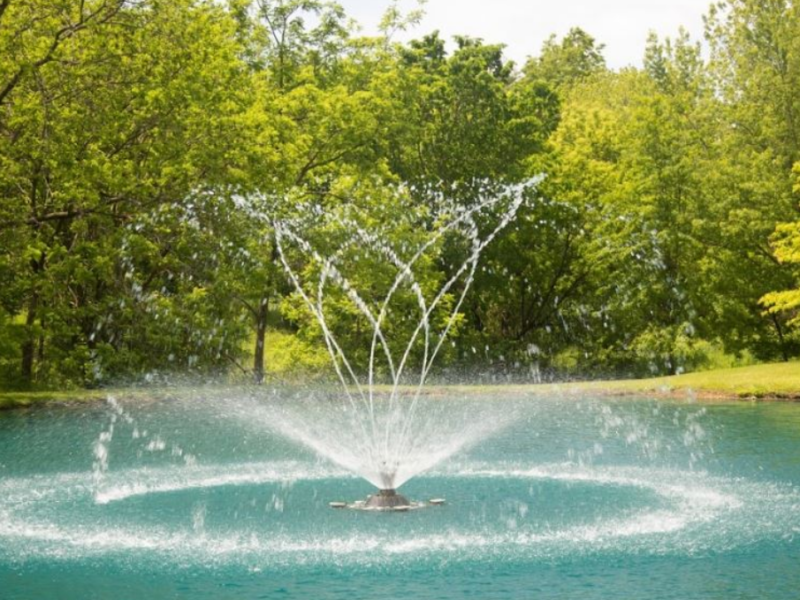Have you ever found yourself sweltering under the hot sun, the air thick with humidity, and desperately seeking relief? As you sweat and regret being outside, you spot an expansive, glistening pool with a breathtaking fountain at its centre. The cool breeze it produces brings a welcome respite.
While these water displays may seem like a luxury reserved for grand hotels and high-end resorts, they’re becoming a common sight in public parks, community gardens and even residential backyards. They combine the beauty of still water with the movement and soothing sound of cascading waves, creating a serene and refreshing environment for both the eyes and ears. In particular, well-designed lake floating fountains can bring a whole new level of elegance to any water feature.
How Do Floating Fountains Work?
Also known as lake aerators or floating aerators, these fountains are designed to circulate and aerate the water in lakes, ponds, and other bodies of water. High-power pumps at their base draw in water from the bottom and push it out through a series of jets or nozzles at the top. This process creates a continuous flow of water, helping to prevent stagnation and oxygen depletion.
What Are the Benefits of Floating Fountains?
While these displays are undeniably beautiful, they also offer numerous benefits for the health and maintenance of a body of water.

They’re functional as well as aesthetic.
Temperature Regulation and Noise Masking
Walking around a humid and sticky city in the summer, you may have noticed that some areas feel cooler than others. This is because of water features like fountains and ponds that help to regulate the temperature through evaporative cooling. Lake floating fountains, in particular, can help to cool the surrounding environment by drawing in cooler water from deeper levels and mixing it with warmer surface water.
Additionally, the sound of falling water can act as a natural white noise, masking any unwanted background noise and creating a more peaceful environment. This is especially useful in urban areas where noise pollution can be overwhelming for both humans and wildlife.
Oxygenation and Water Circulation
When water becomes stagnant, it can quickly become a breeding ground for algae and other harmful bacteria. This leads to a decrease in oxygen levels, which can be harmful to fish and other aquatic life. Even if there are no living creatures in the lake, continuous oxygenation is important for maintaining a healthy ecosystem.

Floating fountains help to aerate the water by creating movement and bringing fresh air into the water. This can also help to prevent foul odours and create a more visually pleasing appearance by reducing the buildup of algae and other debris. For humans, this means being able to enjoy a cleaner and more pleasant environment to swim, fish, or simply relax by the water’s edge.
Wildlife Attraction
In addition to the functional benefits, floating fountains can also attract a diverse range of wildlife. The constant movement and oxygenation of the water can help to support a variety of aquatic plants and animals. This, in turn, can attract birds and other wildlife that rely on these organisms for food and shelter.
When this natural ecosystem remains undisturbed, it can create a balanced environment where all species thrive. This not only benefits the overall health of the lake but also provides an opportunity for humans to observe and appreciate the beauty of nature.
Major Considerations
When you’re trying to decide on floating fountains for large ponds or lakes, you need to look into several aspects that make up the ecosystem.
First and foremost, the size of the body of water should be taken into account. Different fountains have different output levels, and you want to ensure that there is enough movement and oxygenation for the size of your lake or pond. The horsepower of each model is directly related to the size of the water body that it can effectively aerate.
Maintenance and energy consumption should also be considered. While these displays are generally low maintenance, regular upkeep is necessary to keep them running efficiently. Public or commercial displays may require more frequent maintenance due to the higher usage and potential for debris accumulation.
Energy consumption can also vary depending on the model and features. Some options may have energy-saving features such as timers or solar panels, while others may require a consistent power source. It’s important to consider the long-term costs and environmental impact your display may have. While the initial cost of a floating fountain may seem expensive, its energy efficiency and low maintenance can save you money in the long run.
As for water dispersion patterns, it’s important to consider the direction and strength of prevailing winds in your area. This can affect the spray pattern and reach of the fountain, as well as potential water loss due to evaporation. Some popular options include a single stream, mist, multi-tier spray or vertical trumpet designs, each one creating a unique aesthetic for your water feature.
Additionally, lighting accessories can add an extra charming touch to your floating fountain. LED fixtures are a durable and energy-efficient option, providing a beautiful nighttime display. Some models even offer colour-changing options for added visual interest, with the ability to customise the hues and patterns. You don’t have to limit yourself to just one light either, as multiple fixtures can be added for a more dramatic effect.
Finally, any public or commercial installation should also consider safety regulations and proper anchoring techniques. Consult with a professional to ensure your floating fountain is installed correctly and safely for both the public and the environment. Some areas may have specific guidelines or restrictions for using these displays, so it’s important to research and comply with the rules.






